|
Koller - Morss, USCF-92CM76 [C44]
This game was played early in my correspondence practice, and it taught me a painful lesson. My opponent was Brian Koller of Richardson, Texas.
1.e4 e5 2.Nf3 Nc6 3.d4 exd4 4.c3 dxc3 5.Nxc3 Bb4 6.Bc4 d6 7.0-0
[A major alternative is 7.Qb3; see Agulnick-Morss.]
7...Bxc3 8.bxc3 Nf6
This is the move usually relied upon, and in my view, it should be sufficient for the advantage. [8...Bg4!? see Agulnick-Morss.]
9.e5
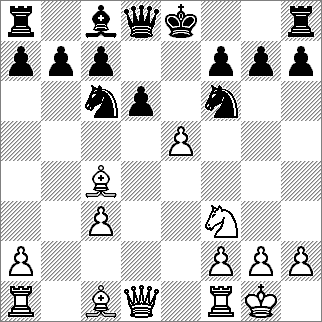
Game position after 9. e5
[Worse is 9.Ba3 as played in Agulnick-Morss.]
9...Nxe5
[9...dxe5 10.Qb3 (10.Ng5 Be6! 11.Bxe6 fxe6 12.Qb3 Qd5 13.Nxe6 Qxb3 14.axb3 Kf7= Aronin.) 10...0-0 11.Rd1 is troublesome for Black.]
10.Nxe5 dxe5 11.Qb3
[11.Qxd8+ Kxd8 12.Bxf7 Ke7 13.Bb3 Be6 leads to a dreary ending for White]
11...Qe7 12.Ba3 c5 13.Bb5+
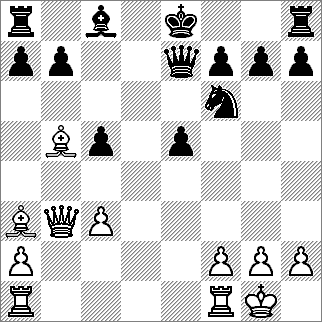
Game position after 13. Bb5+
A critical position.
13...Kf8!?
This has been the theoretical recommendation, but it is not easy to justify in practical play.
Solid and possibly even better for Black is 13...Nd7
A) 14.Rad1 b6 15.Qd5 Rb8 16.Rfe1 0-0 with advantage to Black (16...f6? 17.f4 and White will soon break through);
B) 14.Bxd7+
B1) 14...Qxd7!? may be worth investigating, for example 15.Bxc5 (15.Rfe1 Qc7 appears to favor Black; so does 15.Rad1 Qc6) 15...Qc6 is unclear, but may be promising for Black. If White prevents queenside castling, Black can try an eventual ...f6 and ...Kf7;
B2) 14...Bxd7 15.Qxb7 0-0 16.Rad1 Rfd8 17.Bxc5 (17.Rd2 Qe8 was equal in Velimirovic-Littleton, The Hague, 1966) 17...Qxc5 18.Rxd7 Rxd7 19.Qxa8+ Qf8 20.Qe4 is equal, according to Botterill;
13...Bd7! conforms to the doctrine that a chessfriend of mine refers to as "chess by smell," that is, when faced with a difficult choice, play the move that smells best. I myself have followed his doctrine with some success, and I regret that I didn't do so here. The books say that Black's natural move gives equality at best, but I think Black retains good chances for the win. 14.Bxd7+ Qxd7 15.Bxc5
A) 15...Ne4! 16.Ba3 Nd2 17.Qb4 0-0-0! (17...Nxf1? 18.Rd1 is a cunning trap devised by Ribli, best play being 18...Nd2 19.Rxd2 Qc7 20.Qb5+ Qc6 21.Qxe5+ Qe6 22.Qb5+ Qc6 23.Qe2+ Qe6 24.Qd1 and White wins) 18.Rfd1 (18.Rfe1 Qc7 is good for Black) 18...Qc6!
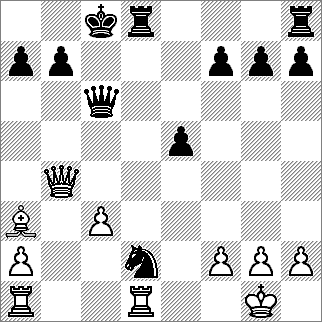
Analysis position after 18...Qc6!
A1) 19.Qe7 Nc4 with an enviable position for Black;
A2) 19.c4 Ne4
A2a) 20.c5 Rxd1+ 21.Rxd1 Rd8 22.Rxd8+ Kxd8 23.f3 (23.Qa5+ Kd7 24.Qxa7 Qd5 is good for Black ) 23...Nf6 24.Qa5+ (Bosch says it's equal here, but I don't think so) 24...Kd7 25.Qxa7 e4! and though the material is even, Black has both the better minor piece and the better pawn structure;
A2b) 20.Qe7 Qf6 21.Qxf6 (21.f3 Qxe7 22.Bxe7 Rxd1+ 23.Rxd1 Re8 and Black keeps his material advantage without any problem) 21...Rxd1+ 22.Rxd1 Nxf6 with a safe extra pawn for Black;
A3) 19.Qa5 Rd5 20.Qxa7 Rhd8 The material is even, but here again Black (who threatens ...Nf3+) has the better minor piece, which will take up a beautiful station on c4. He also has the better pawn structure and prospects of advancing his kingside pawns. Nor do I think White has any real prospects of queenside attack. I prefer Black.;
B) 15...Qc6 16.Ba3 and now:
B1) 16...Nd5 17.Rae1 0-0-0 18.Rxe5 Rhe8 19.Rf5! Qe6 (19...Rd7 was played in Menvielle-Medina, Las Palmas 1972, after which 20.c4 appears favorable to White) 20.Rf3 f6 was Smederevac-Clarke, Wijk aan Zee, 1970, and now 21.c4 with advantage to White, should have been played;
B2) 16...0-0-0 17.Qxf7 Rd7 18.Qb3 Rhd8 19.Rfe1! e4 20.h3! Rd3 21.Be7 Re8 22.Bxf6 gxf6 23.Qf7 Rxc3 24.Qxh7 and according to Bosch, White is better thanks to his passed h-pawn, Black's weak kingside pawns, and Black's exposed king. Bosch-Hoeksema, Groningen 1997.
14.Rfe1
This is unusual, and is probably inferior to the theoretical line. 14.f4! e4 (14...Be6 leads to unclear play) 15.f5 (Diagram) is theory, and is generally considered favorable to Black. But as Bosch observes, Black "is a pawn up on both wings, but he has some problems developing and his king is not safe." Further consideration of this will have to wait for a subsequent column. In this column's games, I have already given the reader a enough to chew on. I will, however, supply the following examples from Groningen, 1997:
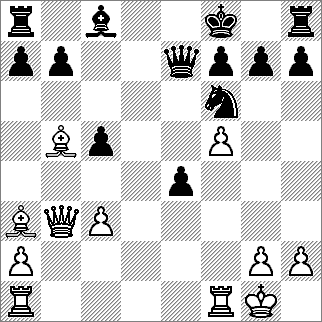
Analysis position after 15. f5
15...b6 (15...Kg8 16.Rad1 h6 17.Bc4 b6? 18.Bxf7+ Kf8 19.Bg6 and White went on to win in Ligterink-Bosch) 16.Bc6 Rb8 17.Qa4 g5 18.c4 Qe5 19.Qc2 Ng4 20.g3 Qd4+ 21.Kh1 Ne3 22.Qf2 Nxf5 23.Qe2 Qd3? (23...Rg8 Hoeksema) 24.Qb2 Rg8? 25.Rad1 Qxc4 26.Qe5 1-0 Blees-Hoeksema.
14...Bf5
Even in this line, Black's game is not so easy to play. But simply as a matter of principle, I wanted to keep my pieces as active a possible.
14...Be6 15.Rxe5 Bxb3 (15...Nd7? 16.Bxd7 Bxb3 17.Bxc5 favors White) 16.Rxe7 Kxe7 17.Bxc5+ Ke6 18.axb3 favors Black but seems to offer White somewhat more compensation that he has in the game, since his two bishops have become very active.
15.Qc4 b6 16.Bb2
16.Bc1 could have been considered.
16...Rd8 17.Qe2 Ne4
I was not certain that I wanted to commit myself to 17...e4, so I chose this instead.
18.Rad1 Rxd1 19.Rxd1 Nd6 20.Qf3
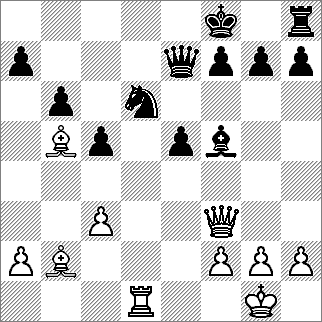
Game position after 20. Qf3
20...g6
This move is a little bit weakening, but I'm not sure that Black has anything better.
20...Be4 21.Qe2 (21.Qh3 f5) 21...f5 22.c4 Kf7 23.f3 Bb7 24.Bxe5 Nxb5 25.cxb5 looks slightly better for Black;
20...Nxb5?! 21.Qa8+ Qe8 22.Rd8 Ke7 23.Rxe8+ Rxe8 24.Qb7+ Kf8 is unclear;
but not 20...Bg6?? 21.Qa8+.
21.Bc1 h5 22.Be2 Bg4
I was pursuing simplification here, but possibly better was 22...Kg7.
23.Qc6 Bxe2 24.Rxd6 Bb5 25.Qd5 Bc4 26.Qd2 Ke8
And so Black must continue to play for a while longer without the services of his rook.
27.Qd1 Be6 28.h3
I'm not sure what White is doing here except biding his time.
28.a4? Bb3
28...g5
I came up with this "ingenious" way of liberating my rook and exploiting White's last move, but it would have been much simpler to play 28...f6! followed soon by ...Kf7.
29.Qd3 Rh6 30.a3 Rg6 31.Qd2 g4 32.hxg4 Rxg4 33.Rd3 Qf6 34.Qd1
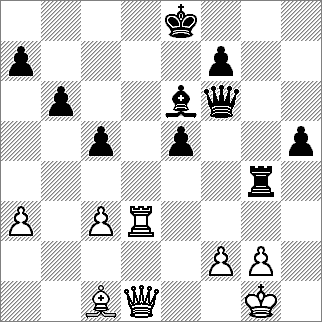
Game position after 34. Qd1
In this position Black's win is essentially guaranteed. But, as will be seen, there is room for error. The signals for danger, which I did not, sadly, adequately recognize at the time, are the presence of opposite-colored bishops, the attendant weakness of the kingside dark squares, and the weakness of the back rank.
34...Qg6?
34...Kf8 35.Rd8+ Kg7 36.Qd6 Kh7 followed soon by ...Qg7 looks solid enough.
35.Rd8+
Koller sent this move with the comment, "My suffering has been rewarded" and indeed it had.
35...Ke7 36.Rh8!
White now obtains extremely strong counterplay on the dark squares. Here I did some analysis which appeared to show best play would lead to perpetual check of Black's king, so I offered the draw. My opponent accepted, but he should have continued, since Black has to play well to hold the draw. What follows is analysis.
36...Rxg2+
36...Kf6 37.Rh6 Rxg2+ 38.Kh1 Qxh6 39.Bxh6 Rg4! 40.Qd8+ Kf5 41.f3 Rg6 42.Be3 favors White fairly clearly.
37.Kh1

Analysis position after 37. Kh1
37...Bd7!
37...Bd5? When I offered the draw, I thought this would be the way. I don't know if I would actually played this had the game continued, but the thought is scary. 38.Qxd5
A) 38...Rxf2 39.Qxe5+ Kd7 40.Qe8+ Kc7 (40...Kd6 41.Rh6+-) 41.Bf4+ Rxf4 42.Qb8+ and White picks up a loose rook;
B) 38...Rg1+ 39.Kh2 Rxc1 40.Qd8+ Ke6 41.Re8+ Kf5 42.Qd3+ Kf6 43.Qd6+ and White is winning. (In my original analysis, I foresaw only 43.Qd8+ Kf5 44.Qd3+ Kf6 45.Qd8+ with a seeming perpetual) Thus 43...Kg7 (43...Kf5 44.Qxe5+ Kg4 45.f3+ Kxf3 46.Qe3+ Kg4 47.Re4+ and White wins) 44.Qxe5+ f6 (44...Qf6 45.Rg8+) 45.Qc7+ Kh6 46.Rh8+ Kg5 47.Qg3+ Kf5 48.Qd3+ Kg5 49.f4+ and White's attack bags Black's queen.
38.Rh6 Qg7
Black can try for a win with 38...Qc6!? 39.Rxc6 Bxc6 40.f3 Rg3 but I doubt that Black's rook and pawns are worth as much as White's queen.
39.Qd6+ Kd8 40.Qb8+ Ke7 41.Qd6+ and draws. ½-½
The lesson I drew from this was that it is extremely important to be cautious when the constellation of opposing forces involves the heavy pieces and opposite colored bishops. In that context, it is very dangerous to allow the opponent to gain the intiative. Here, I was fortunate that the cost was only 1/2 point. Also, my play leading up to my error was marked by overconfidence. I played 34...Qg6 quickly, thinking that White would surely have to resign soon.
Send your comments to:
blackdog@netwalk.com.
|